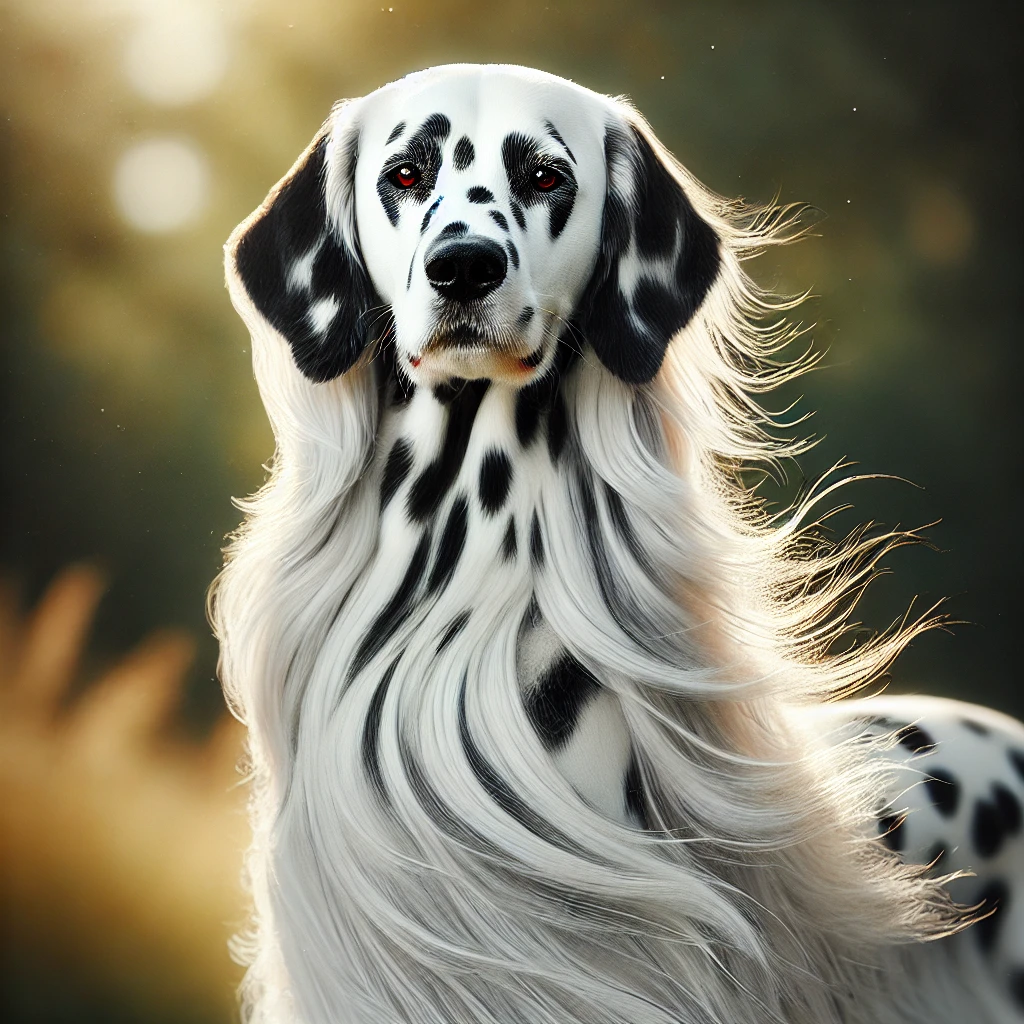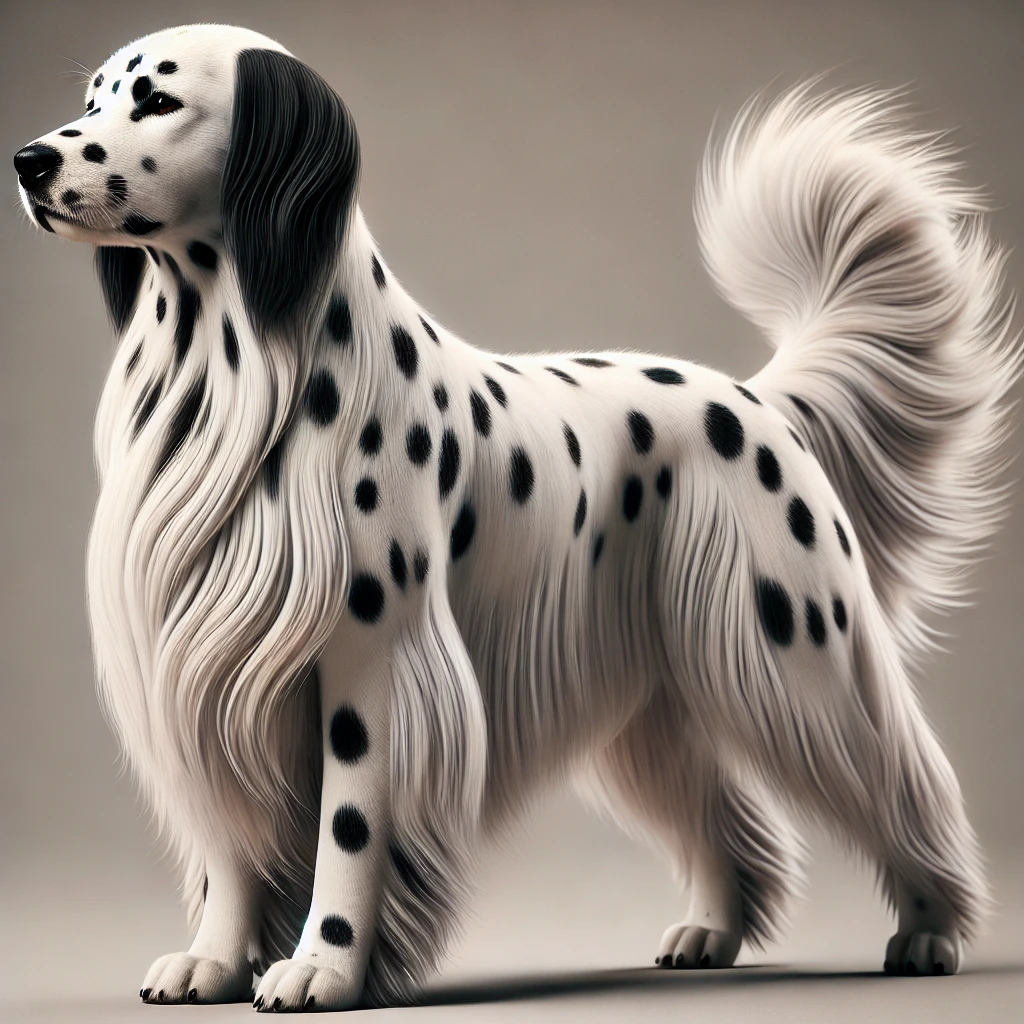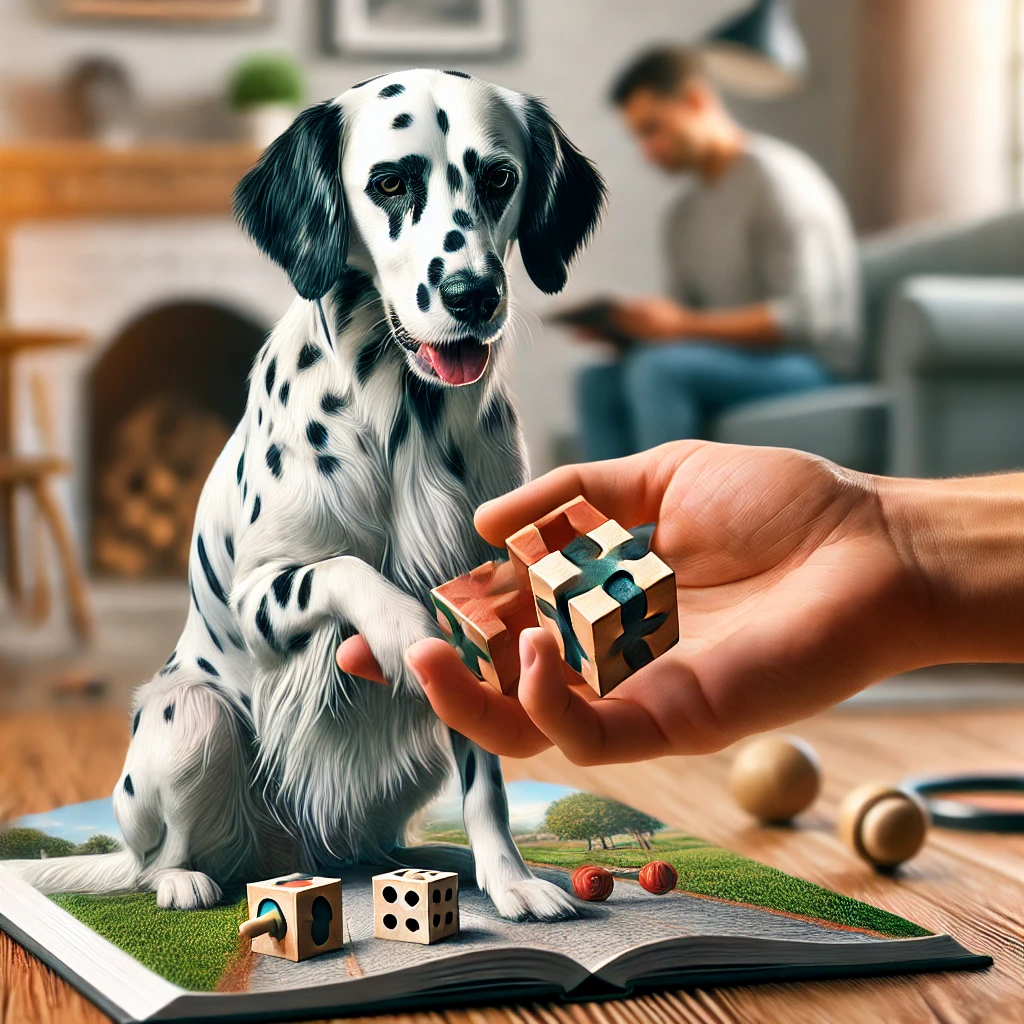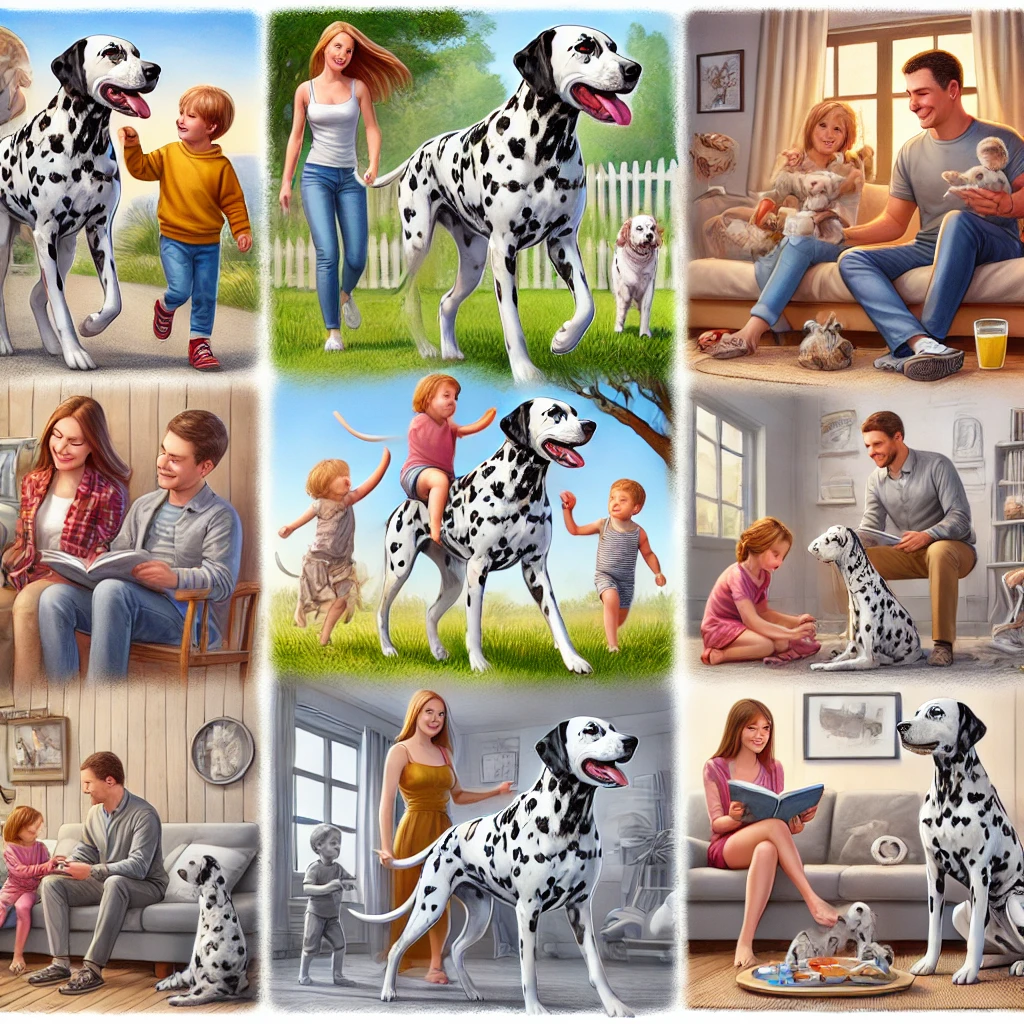
The long haired Dalmatian, with its rare and beautiful coat, has been gaining attention among dog lovers.
Known for their distinct spotted fur, Dalmatians are a breed that stands out, but the long haired variety adds an extra layer of charm.
However, owning a long haired Dalmatian is not for everyone. Before making a decision, it’s essential to understand the breed’s unique characteristics and whether it fits your lifestyle.
In this guide, we’ll explore everything you need to know about the long haired Dalmatian, from their temperament and care requirements to how they compare to their short-haired cousins.
Overview of the Long Haired Dalmatian
1. History and Origins
The long haired Dalmatian is a rare variation of the traditional Dalmatian breed, emerging from a recessive gene responsible for the longer coat.
While Dalmatians have long been associated with their iconic short coats, the long haired variety has existed for as long as the breed itself, though they have been less widely accepted due to historical breeding preferences.
In fact, the long coat was often considered undesirable by breeders because the breed standard for Dalmatians favored short fur.
Dalmatians originated in the Dalmatia region of Croatia and were historically bred as carriage dogs.
Their duties involved running alongside horse-drawn carriages, protecting the cargo and calming the horses.
The breed’s loyalty and intelligence made them highly effective in this role.
Over time, their unique appearance and bond with horses led to their famous role as firehouse dogs, where they guarded the stations and accompanied horse-drawn fire trucks.
While long haired Dalmatians share this rich heritage with their short haired counterparts, they remain rare today.
Though they are not officially recognized by major kennel clubs due to the breed standard, enthusiasts appreciate their striking look and gentle personalities, and they have gained popularity among niche dog lovers.
2. Physical Characteristics

The most obvious difference between a long haired Dalmatian and the traditional short haired version is their coat.
Long haired Dalmatians have a medium to long, soft, and sometimes fluffy coat that sets them apart.
Their fur can be more pronounced around the ears, chest, and tail, giving them a slightly different, more rugged appearance while maintaining the sleekness of their body shape.
Just like their short haired relatives, long haired Dalmatians are medium-sized dogs with a muscular, athletic build.
They typically weigh between 45 and 70 pounds, with males being slightly larger than females.
They stand between 19 and 24 inches tall at the shoulder, making them a well-balanced and agile breed, known for their grace and power.
Their characteristic spots—either black or liver-colored—are distributed randomly across their white coat, maintaining the classic Dalmatian look.
Long haired Dalmatians’ spots are as distinctive as their short haired counterparts, making them instantly recognizable.
The breed has dark brown or amber eyes, depending on their spot color, and a long snout with a strong jaw.
Their high-set ears often look even more charming with their additional fluff, giving them a distinctive and elegant appearance.
3. Temperament and Personality
Long haired Dalmatians are known for their high energy, intelligence, and playful demeanor.
Much like the traditional Dalmatian, they thrive in environments where they can be active and mentally engaged.
These dogs are loyal companions, bonding deeply with their families and displaying an affectionate nature.
Despite their energetic tendencies, they are known for being quite sensitive to their owners’ emotions, which makes them highly attuned to the moods and needs of their human companions.
This breed can sometimes exhibit a streak of independence or stubbornness, which may make training a challenge for first-time dog owners.
However, with consistent, positive reinforcement, they can learn quickly and excel in a variety of activities, including agility training and obedience competitions.
Early socialization is crucial to help them grow into well-mannered adults, particularly around strangers and other animals.
Long haired Dalmatians are social animals and generally get along well with children, especially if they are raised together.
They make great family dogs, thanks to their playful and protective nature.
However, due to their high energy levels, it’s important to ensure that children are supervised during playtime to avoid accidental rough play or knocks.
While they can get along with other pets, it’s important to introduce them to smaller animals, such as cats or rabbits, cautiously, as their prey drive may lead to chasing behaviors.
Proper training and early exposure to other animals will help mitigate this issue and foster a peaceful multi-pet household.
4. Grooming Needs
Unlike their short haired counterparts, long haired Dalmatians require more grooming to keep their coat healthy and tangle-free.
Regular brushing, at least two to three times a week, is essential to reduce shedding and prevent their fur from matting.
Since their coat can grow longer around the ears, tail, and chest, these areas may require extra attention to prevent tangles.
While long haired Dalmatians are not hypoallergenic, they shed less frequently than some other long-coated breeds, although they do shed year-round.
Regular bathing, about once every few months or as needed, will help maintain the cleanliness of their coat.
Additionally, owners should pay attention to their ears, which can become prone to infections if not cleaned regularly.
For owners who prefer a low-maintenance dog, the grooming needs of a long haired Dalmatian may be considered a bit more demanding than those of their short haired cousins, but the effort is worth it to keep their beautiful coats looking their best.
5. Activity and Exercise Requirements

All Dalmatians are highly energetic, and the long haired Dalmatian is no exception.
This breed requires daily exercise to maintain both their physical and mental well-being.
A long daily walk, jog, or a vigorous play session in a large, secure area is necessary to keep them happy and to prevent boredom or destructive behaviors.
Given their intelligence, long haired Dalmatians also need mental stimulation.
They enjoy games like fetch, puzzle toys, and interactive play that challenge their minds as much as their bodies.
Engaging them in activities such as agility training, obedience courses, or canine sports can provide the stimulation they need.
Without sufficient exercise and mental engagement, long haired Dalmatians can become restless or even develop behavioral issues.
They are best suited to active families or individuals who can commit time each day to keeping them engaged and fit.
6. Health and Common Issues
Like all breeds, long haired Dalmatians have their share of health concerns.
One of the most well-known health issues for Dalmatians is congenital deafness.
Around 10-12% of Dalmatians are born deaf in both ears, while a larger percentage may have hearing loss in one ear.
Responsible breeders will conduct BAER (Brainstem Auditory Evoked Response) testing to ensure that puppies have normal hearing.
Additionally, long haired Dalmatians may be prone to hip dysplasia, a common issue in larger breeds that can affect mobility as they age.
Maintaining a healthy weight and providing regular exercise can help prevent or manage this condition.
Dalmatians are also prone to urinary issues, particularly the formation of urinary stones.
This is due to their unique metabolism of purines, so a diet low in purines (found in organ meats and certain proteins) is recommended.
Providing fresh water at all times and encouraging frequent urination can help minimize this risk.
With regular vet checkups, a proper diet, and an active lifestyle, long haired Dalmatians can live healthy, happy lives, with a typical lifespan of 10 to 14 years.
Care Requirements for a Long Haired Dalmatian

Long haired Dalmatians, while visually striking and affectionate companions, come with specific care needs that prospective owners should be prepared for.
From grooming and exercise to diet and health considerations, taking good care of a long haired Dalmatian ensures they remain happy, healthy, and well-adjusted.
Here’s a detailed breakdown of what to expect.
1. Grooming
The long haired Dalmatian’s coat is its most distinguishing feature, and it requires regular maintenance to stay in top condition.
Unlike their short haired counterparts, whose coats are relatively low maintenance, long haired Dalmatians need a more thorough grooming routine.
Brushing
To keep their coat free from tangles and matting, long haired Dalmatians should be brushed at least two to three times per week.
Regular brushing helps remove loose hairs and prevents mats, especially in areas like behind the ears, along the chest, and around the tail, where their fur tends to grow thicker.
It also helps distribute natural oils across their coat, keeping it shiny and healthy.
You can use a pin brush or a slicker brush for their coat, depending on how long and thick their fur is.
Shedding Management
While long haired Dalmatians are not hypoallergenic, they shed year-round like other Dalmatians.
Regular brushing reduces shedding, but owners should still expect to deal with some fur around the house.
For more shedding-prone times, like spring and fall when dogs naturally shed their winter or summer coats, brushing frequency may need to increase to daily sessions.
Bathing
Long haired Dalmatians generally don’t require frequent baths.
A bath every two to three months or as needed when they get dirty will suffice.
Too much bathing can strip their skin of natural oils, leading to dryness or irritation, so it’s important not to over-bathe them.
Use a dog-specific shampoo that’s gentle on their skin and won’t cause irritation, especially since Dalmatians can sometimes suffer from skin allergies.
Ear Cleaning
The long fur around their ears can trap moisture and dirt, making them prone to ear infections if not cleaned regularly.
Owners should check their ears weekly and clean them with a vet-approved ear cleaner to prevent infections.
Be cautious not to insert anything deep into their ears; simply wipe away visible debris.
Nail Trimming and Dental Care
Long haired Dalmatians, like all dogs, require regular nail trimming, typically every 3-4 weeks, depending on how active they are.
Keeping their nails at a healthy length prevents discomfort or injury.
Additionally, maintaining good dental hygiene is crucial.
Brush their teeth a few times a week using a dog-specific toothbrush and toothpaste to prevent plaque buildup and maintain healthy gums.
2. Exercise and Activity Levels
Long haired Dalmatians are energetic dogs that require plenty of exercise to stay happy and healthy.
Their high energy levels stem from their working-dog ancestry, where they ran long distances alongside carriages.
They need both physical and mental stimulation to prevent boredom and destructive behaviors.
Daily Exercise Needs
Dalmatians, in general, need at least 60 to 90 minutes of exercise per day.
This can include brisk walks, jogs, or off-leash play in a secure yard or park.
They also enjoy games of fetch, agility courses, or hiking adventures.
Without enough exercise, they may develop behavioral issues, including chewing, barking, or restlessness, as their energy levels are not being properly channeled.
Mental Stimulation

In addition to physical exercise, long haired Dalmatians thrive on mental stimulation.
This can include puzzle toys, obedience training, and interactive games.
Since they are intelligent dogs, activities that engage their mind—like scent games, teaching new tricks, or participating in dog sports like agility or rally—are ideal.
Mental stimulation prevents boredom and challenges them in ways that simple physical activity might not.
Off-Leash Considerations
While long haired Dalmatians enjoy running, it’s important to note that they have a strong prey drive.
This means that in unsecured areas, they may be tempted to chase after squirrels, birds, or other small animals.
Always exercise caution when allowing them off-leash, and ensure they are in a fenced area or well-trained in recall commands.
3. Dietary Needs
A balanced diet is essential to keep your long haired Dalmatian healthy, support their energy levels, and maintain their beautiful coat.
High-Quality Dog Food
Long haired Dalmatians should be fed a high-quality dog food that provides the nutrients they need for their active lifestyle.
Whether you opt for commercial kibble, wet food, or raw feeding, ensure that the food is balanced with appropriate amounts of protein, healthy fats, and fiber.
Since Dalmatians are prone to urinary stones due to their unique metabolism, a diet low in purines is often recommended.
This means avoiding organ meats, certain fish, and some grains that are high in purines.
Portion Control and Weight Management
Because Dalmatians are active dogs, they generally need a higher caloric intake than some other breeds.
However, it’s important to monitor their weight and adjust their portions accordingly to prevent obesity.
Consult with a vet to determine the correct portion sizes based on their age, activity level, and overall health.
Obesity can lead to joint issues, especially hip dysplasia, which Dalmatians are prone to.
Water Intake
Dalmatians are known to be more susceptible to urinary issues, such as the formation of urinary stones, due to their difficulty in processing purines.
To combat this, it’s important to ensure they always have access to fresh water to keep their urinary system healthy.
Encourage frequent drinking and consider feeding them wet food or adding moisture to their meals if they are not naturally inclined to drink enough water.
Supplements for Coat and Joint Health

For long haired Dalmatians, supplements like fish oil (rich in omega-3 fatty acids) can help maintain their coat’s luster and support healthy skin.
Additionally, because Dalmatians are prone to joint issues like hip dysplasia, glucosamine and chondroitin supplements may help maintain joint health as they age.
4. Health Considerations
Long haired Dalmatians, like all breeds, have specific health issues that owners should be aware of.
Proper care and regular veterinary check-ups are crucial for detecting any potential problems early on.
Congenital Deafness
One of the most common health issues in Dalmatians is congenital deafness. It’s estimated that about 10-12% of Dalmatians are born deaf in both ears, while another percentage may experience partial hearing loss.
Responsible breeders perform BAER (Brainstem Auditory Evoked Response) testing on puppies to determine their hearing status.
If you’re adopting a long haired Dalmatian puppy, ensure that the breeder has performed this test to give you an accurate understanding of the dog’s hearing.
Hip Dysplasia
Like many larger breeds, long haired Dalmatians are prone to hip dysplasia, a condition where the hip joint doesn’t develop properly.
This can lead to arthritis and mobility issues later in life. Regular vet check-ups and maintaining a healthy weight can help manage this condition.
Additionally, providing appropriate joint supplements and keeping them active (but not over-exerted) will contribute to joint health.
Urinary Issues
Dalmatians are known to be at risk for urinary stones, specifically urate stones, due to their unique metabolism.
This is why it’s important to feed them a low-purine diet and ensure they drink plenty of water.
Regular vet check-ups that include urine analysis can help catch any issues early before they become serious.
Skin Allergies
Long haired Dalmatians may also be prone to skin allergies, which can manifest as itchiness, dry skin, or rashes.
Ensuring that their diet is rich in omega fatty acids and keeping up with regular grooming can help prevent skin issues.
If skin problems persist, consulting a vet for allergy testing or treatment options may be necessary.
5. Time and Commitment
Owning a long haired Dalmatian requires significant time and dedication. Between their grooming, exercise, and social needs, they are not a breed for passive owners.
They thrive in homes where they are given plenty of attention, companionship, and activity.
These dogs are loyal and loving but will need consistent training and care to live a fulfilling and healthy life.
If you’re able to meet their care requirements, long haired Dalmatians can make wonderful, affectionate companions for many years.
Is a Long Haired Dalmatian a Good Fit for Your Lifestyle?

Home Environment
Long haired Dalmatians can adapt to a variety of living situations, but they thrive in homes with access to outdoor spaces where they can run and play.
While they can live in apartments, they will need more exercise and outdoor time to compensate for the lack of space.
Families with yards or access to parks are ideal for this breed.
Time Commitment
Owning a long haired Dalmatian requires a significant time commitment.
Between grooming, exercising, and training, you will need to dedicate daily time to keeping them happy and healthy.
This breed is not suitable for people with very busy schedules or those who cannot commit to regular physical activities.
Family Considerations
Long haired Dalmatians generally make great family pets.
They are good with children and tend to be protective, forming strong bonds with their family members.
However, their energy levels may be too much for very young children.
Supervision is recommended when interacting with kids to ensure both the dog and child play safely.
Training
Dalmatians are intelligent but can be stubborn at times. Positive reinforcement training works best with them.
Consistency, patience, and early training will help ensure they grow into well-behaved adults.
If you are new to dog ownership, consider enrolling in a basic obedience class to ensure proper training from an early age.
Long Haired Dalmatian vs. Standard Dalmatian

While the long haired Dalmatian shares many characteristics with its short-haired counterpart, there are a few key differences.
The main one is the grooming requirement—long haired Dalmatians require more frequent brushing and maintenance to prevent their coats from tangling.
Temperament and personality traits are generally the same between the two, though individual dogs may vary.
Costs and Financial Considerations
Upfront Costs
Long haired Dalmatians can be more expensive to purchase due to their rarity.
Depending on the breeder and location, prices can range anywhere from $1,000 to $3,000 or more for a puppy.
Ongoing Costs
Ongoing expenses include grooming tools or professional grooming services, high-quality dog food, toys, veterinary care, and pet insurance.
Because of their health risks, regular check-ups and preventative care are essential, which can add to the cost of owning this breed.
Where to Find a Long Haired Dalmatian
Finding a long haired Dalmatian may take time due to their rarity.
Start by looking for reputable breeders who specialize in Dalmatians and can provide information about the specific lineage of long haired puppies.
Rescue organizations or breed-specific rescue groups may also have long haired Dalmatians available for adoption.
Conclusion: Is the Long Haired Dalmatian Right for You?
In conclusion, the long haired Dalmatian is a beautiful and unique breed that requires a lot of care, attention, and energy.
If you have the time, space, and commitment to meet their grooming and exercise needs, they can be a wonderful addition to your family.
However, if you are not ready for the time and effort it takes to raise an active dog with grooming requirements, the long haired Dalmatian might not be the best fit.
Ultimately, your decision should reflect your lifestyle and the time you are willing to dedicate to this loyal and energetic companion.
FAQs Section
- Are long haired Dalmatians hypoallergenic?
No, long haired Dalmatians are not hypoallergenic. They shed regularly and require frequent grooming to minimize shedding. - How long do long haired Dalmatians live?
The average lifespan of a long haired Dalmatian is 10-14 years, similar to the standard Dalmatian. - Are long haired Dalmatians harder to train?
Not necessarily, but they can be stubborn. Consistent, positive reinforcement training works best for this breed.
Have more questions about the long haired Dalmatian?
Leave a comment below, and don’t forget to subscribe to our newsletter for more tips on finding the perfect dog breed for you!
Related Articles:
Low Maintenance Dogs That Don’t Shed Much (And Are Great for Allergies!)



